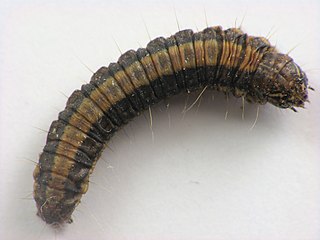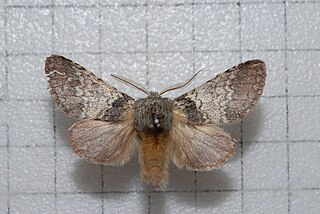
Polyommatus is a diverse genus of butterflies in the family Lycaenidae. Its species are found in the Palearctic realm.

Pterolonchidae is a small family of very small moths in the superfamily Gelechioidea. There are species native to every continent except Australia and Antarctica.

Cimeliidae, the gold moths, is a family of moths that is now placed in the macroheteroceran superfamily Drepanoidea, although previously placed in its own superfamily. Uniquely, they have a pair of pocket-like organs on the seventh abdominal spiracle of the adult moth which are only possibly sound receptive organs. They are quite large and brightly coloured moths that occur in southern Europe and feed on species of Euphorbia. Sometimes they are attracted to light. The family was first described by Pierre Chrétien in 1916.

Pamiria is a Palearctic genus of butterflies in the family Lycaenidae.

Agriphila is a genus of small moths of the family Crambidae. It was first described by Jacob Hübner in 1825. They are common across temperate Eurasia and in adjacent regions.

Carmara is a monotypic moth genus of the family Noctuidae. Its only species, Carmara subcervina, is found in Sri Lanka, Japan, Taiwan, Borneo and Australia. Both the genus and species were first described by Francis Walker in 1864.
Agnorisma bugrai, the collard dart, is a moth of the family Noctuidae. The species was first described by Ahmet Ömer Koçak in 1983. It has a transcontinental distribution in North America, from central Canada and the northern United States, southward in the Rocky Mountains to Colorado.

Aglossa is a genus of small moths belonging to the family Pyralidae. It was described by Pierre André Latreille in 1796. They are found mainly in western Eurasia, though some species have been introduced elsewhere.

Bepea is a moth genus in the subfamily Spilomelinae of the family Crambidae.

The Epipaschiinae are a subfamily of snout moths. Almost 600 species are known today, which are found mainly in the tropics and subtropics. Some occur in temperate regions, but the subfamily is apparently completely absent from Europe, at least as native species. A few Epipaschiinae are crop pests that may occasionally become economically significant.
Papilio chrapkowskoides, the broadly green-banded swallowtail, is a species of swallowtail butterfly from the genus Papilio that is found in the Republic of the Congo, Uganda, Rwanda, Burundi, Tanzania, Guinea, Sierra Leone, Liberia, Ivory Coast, Ghana, Togo, Benin, Nigeria, Cameroon, Gabon, the Democratic Republic of the Congo, and Angola.

Elegia is a genus of snout moths. It was described by Émile Louis Ragonot in 1887.

Pseudofentonia is a genus of moths of the family Notodontidae erected by Embrik Strand in 1912.
Polyommatus anticarmon, the anticarmon blue, is a butterfly in the family Lycaenidae. It was described by Ahmet Ömer Koçak in 1983. It is found in Turkey.

The Zeuzerinae are a subfamily of the family Cossidae.
Pelagodes clarifimbria is a moth of the family Geometridae first described by Prout in 1919. It is found in Sri Lanka, Peninsular Malaysia and Borneo.
Stathmopoda masinissa, the persimmon fruit moth, is a moth of the family Stathmopodidae. The species was first described by Edward Meyrick in 1906. It is a serious pest on several persimmon species. It is found in several Old World countries Japan, Korea, Australia, Sri Lanka, Thailand and China.
Leucania venalba is a moth of the family Noctuidae first described by Frederic Moore in 1867. It is found in Indo-Australian tropics of India, Sri Lanka, to Fiji and New Caledonia.
Autoba brachygonia is a moth of the family Erebidae first described by George Hampson in 1910. It is found in Sri Lanka.
Nola squalida is a moth of the family Nolidae first described by Otto Staudinger in 1870. It is found in Turkestan, Himalaya, Sikkim, Bhutan, China, India and Sri Lanka.












